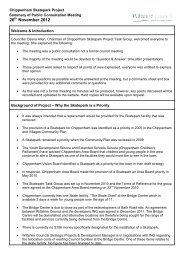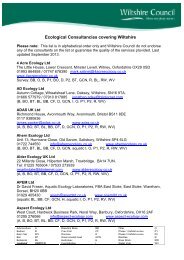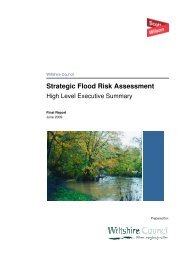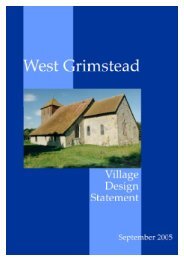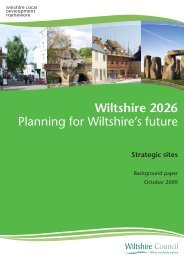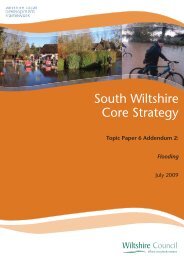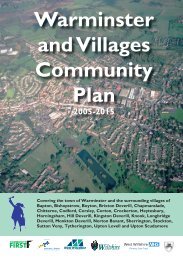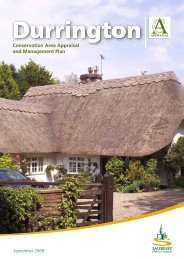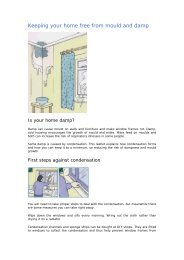South Wiltshire Core Strategy - Wiltshire Council
South Wiltshire Core Strategy - Wiltshire Council
South Wiltshire Core Strategy - Wiltshire Council
You also want an ePaper? Increase the reach of your titles
YUMPU automatically turns print PDFs into web optimized ePapers that Google loves.
4. Tackling local needs - the issues, problems and<br />
challenges facing south <strong>Wiltshire</strong><br />
4.1 The challenge of planning for a spatially diverse area.<br />
4.2 This strategy is based on a systematic approach to identify the issues and challenges<br />
faced by south <strong>Wiltshire</strong> and how they might be resolved. <strong>South</strong> <strong>Wiltshire</strong> is a rich<br />
and varied part of the Country and the issues and challenges within it vary from place<br />
to place. It would be a mistake to develop a strategy which is based on 'one size fits<br />
all' solutions. Accurately identifying the role that south <strong>Wiltshire</strong>’s settlements have<br />
with regard to the location of services, jobs and housing is a critical consideration in<br />
trying to balance the needs of the environment with the needs of the communities.<br />
This way, the Spatial <strong>Strategy</strong> is rooted in the distinctive character of specific places<br />
and tailored to solving their particular sets of problems.<br />
4.3 A <strong>Strategy</strong> of Managed Growth - Identifying Pressures leading to<br />
Local Housing Needs<br />
The <strong>Strategy</strong> plans for managed growth to deliver the new houses required to meet<br />
local needs. The levels of growth required accord with those set out in the emerging<br />
RSS of 12,400 houses to be delivered in the Salisbury Housing Market Area (“HMA”)<br />
of south <strong>Wiltshire</strong> between 2006 and 2026. This figure is not arbitrary, but based on<br />
local needs as revealed by analysis of the evidence 8 . In particular the following<br />
challenges have been identified:<br />
4.3(a) The need to address the acute shortfall in affordable homes.<br />
The number of households requiring some form of affordable housing 9 is at 702 per<br />
year between 2006 and 2009. At 1st April 2006, 2,968 households were on the<br />
council’s waiting list. Average house prices stand at £247,819, yet the incomes of<br />
92% of those seeking to enter the housing market average are inadequate to allow<br />
them to do so. This highlights acute need in our housing market. 10<br />
4.3(b) The need to use the market to provide more affordable homes<br />
The main way to meet the majority of affordable housing need is by requiring house<br />
builders to provide a proportion of such homes in their developments. This plan<br />
requires 40% of such homes to be delivered in all new schemes of 15 houses or<br />
more and 25% on developments of 5 to 14 houses. Smaller developments will be<br />
required to make a commuted sum payment 11 .<br />
4.3(c) The need to plan for the population living longer and together in smaller<br />
numbers<br />
The proportion of the population aged 65 and over will increase by just less than<br />
10,000 by 2026, whilst the economically active age groups will remain relatively<br />
constant. Social trends also point towards the fact that more 1 and 2 person<br />
households will form during the period to 2026, meaning that more homes will be<br />
needed relative to the population. This creates a need that must be planned for 12 .<br />
4.3(d) The need created by a growing population.<br />
By 2026 the population of south <strong>Wiltshire</strong> will be likely to have grown by about<br />
14,000. This presents a clear need for new housing to be built to meet demand 13 .<br />
8 see Topic Paper 2, 'Housing' para's 1.2 and 1.3, pages 13 -21<br />
9 "Affordable housing is housing (including low cost market and subsidised houses (irrespective of<br />
their tenure/ownership/financial arrangements) which is available in perpetuity to those households<br />
who are financially unable to compete in the local market (for rent or for sale) to secure a suitable<br />
home"<br />
10 see Housing Need & Market Survey by DCA, section 9 page 66 onwards<br />
11 see Affordable Housing Viability Study by Adams Integra<br />
12 see Topic Paper 4, 'Supporting Communities' page 12, Fig 2, 'age structure'.<br />
13 see Draft Regional Spatial <strong>Strategy</strong> for the <strong>South</strong> West, pages 24 to 26.<br />
16



